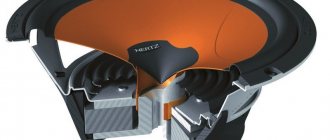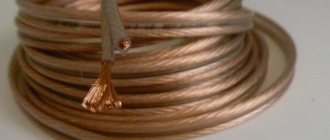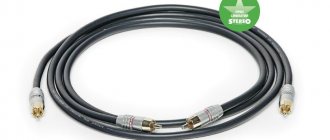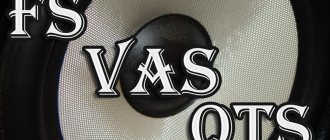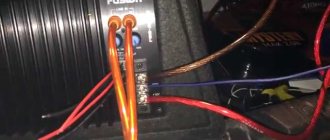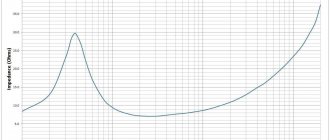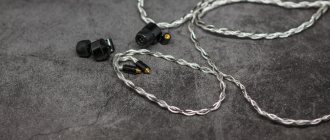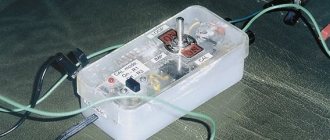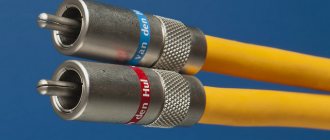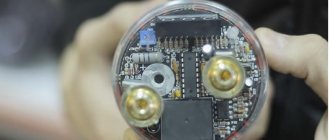In the modern world, every car has a radio and several speakers for listening to radio or music, but car owners are not always satisfied with the playback quality, and they tune the audio system. To improve the quality of the sound output, many install subwoofers and additional speakers, but some forget that this is additional equipment that must be connected correctly.
Car radio
Safety and better sound depend not only on the components of the audio system, but also on the wires through which the signal is transmitted. Which cable to choose for connecting a subwoofer, and what wires are required to connect an active or passive subwoofer?
Connecting an active subwoofer
Selection and types
To connect an amplifier to a car audio system, you must use only high-quality system components and wires. The use of cheap cables can lead to a wide variety of consequences - from poor sound quality to short circuits and fire. For this reason, many car owners have a question: which subwoofer cable to choose and what types are they?
Amplifier cable
When connecting, several types of cables are used:
- Power – provides the system with electricity from a battery or generator.
- RCA cable for subwoofer (interconnect) - transmits the signal from the radio to the receiver and amplifier.
- Acoustic – delivers an amplified signal to the car speakers.
- Manager – is responsible for turning off the subwoofer.
The speaker cable for the subwoofer and the power cable has almost the same structure. They differ only in the number of cores and insulation (thickness).
Types of cables
Materials
Both the price and quality of the entire wire depend on the material from which the cable is made. This means that the better the wire, the more expensive it will be, but at the same time it will provide better sound to the entire system.
Acoustic, power and interconnect (RCA) wires are made from the following materials:
- Aluminum is not a very high-quality analogue of copper wire. The advantages are considered to be low cost, light weight and a huge selection of offers on the market. The disadvantages are much more serious: fragility, poor conductivity, high resistivity and a number of other disadvantages make the material cheap, but not recommended for installation, despite its high prevalence.
- Copper, tinned copper is the most common material that meets all the necessary requirements. Cheaper than silver and is in great demand among car owners who decide to improve their sound system. Tinned copper is more durable and easier to solder (due to the tin layer).
- Silver, silver-plated copper is the best conductor and material used in the manufacture of wires. There is a theory that wires made of this material embellish the upper range and distort the sound, but it has not been confirmed. Excellent for acoustics with a not very sensitive tweeter, leveling out the amplitude-frequency characteristics.
It can be concluded that, despite the quality of silver, copper cable for the subwoofer to the receiver and other components is more popular, and it is believed that it provides cleaner and better sound.
Insulation
Silicone insulation is most often used in automotive wires. It is required to prevent contact of the wire with metal and to protect the cable from the external environment. The operating temperature range ranges from -60 to 1800C.
Cable insulation is often silicone
In some cables, insulation is used to visually increase the cross-sectional area of the wire. Such a wire will be well protected, but the performance will not improve.
Connectors
One of the most popular connectors for professional acoustics is Nuetrikspeakon. In most cases, they are equipped with connectors on both sides, such as “male” or “female” in a small tube for safety.
Varieties of Nuetrikspeakon can be 2, 4, 8 pins. The most common are 4-pin, allowing the use of low- and high-frequency subwoofers without additional wires.
Cross-section (thickness) of the speaker cable in AvtoZvuk
Cross-section (thickness) of the speaker cable in AvtoZvuk
Hello, dear subscribers, Peter Buticar is with you. I apologize for another long lull. Someone even on the channel began to say that I abandoned it, but in reality everything is not so, it’s just a slight calm before the storm of new releases. And today’s issue will be devoted to what cross-section of speaker cables you should use in your car music system. In fact, our today's episode will be a small experiment. We'll just take a cable with a cross section of 1.3 square meters. mm, 2*1.3, to be more precise.
Stinger tinned acoustic cable.
And let’s try to use it to check what is the optimal cross-section of speaker wire to use for the midbass, tweeter, midrange, or perhaps even subwoofer. What will we do in today's episode? From this cable, here 24 meters, we will cut four pieces of six meters each and, connecting it to one or another speaker, we will increase the cross-section by adding these cables. That is, we will have four segments of six meters each. First we will listen to a speaker with a cross-section of 1.3 square, then with a cross-section of 2.6, 3.9, and then with the maximum cross-section of 5.2 square. mm. Let's see if there is any difference.
In the world of car audio, there is a certain opinion that has already been formed and, in principle, I have always used this opinion. That, as a rule, an acoustic cable with a cross-section of 2 * 2.5 is used for midbass in a car, for mid-frequency speakers, tweeters, a cable with a cross-section of 1.5 kW, maybe 1 kW. mm. And for the subwoofer, as a rule, a cable with a thickness of 3 square meters or more is used. That is, these are generally accepted frameworks by which most installers operate and they are described in various publications and on forums.
Today I want to make sure with you that this selection of cross-section is relevant and correct. In fact, today we will not measure the thickness of the cables, apply some sines and measure the difference at the input and output of this cable - engage in all such “nonsense”. We will do it differently: we will take a speaker, add up all the wires, see how the speaker will play with a maximum cross-section with a wire length of 6 meters, this is the standard for almost any car, and then see how the same speaker will play with a cross-section of 1.3 square. It may even happen that there will be no difference. And in fact it will turn out that it is advisable to even throw a very thin wire to the midbass and it will work quite adequately. Honestly, before the test I don’t know what the results will be. More precisely, I know that there should be some difference, but it is difficult for me to imagine to what extent this difference will be. Please note that we will not be testing one speaker cable with another today. Some PVS with an expensive AudioQuest cable, for example. We will test the same cable, just with a different cross-section. I took a Stinger cable for my test; I could have taken any other one. In principle, you can conduct such a test at home or in the garage and see what happens for you.
We will listen to all this directly on a car speaker, more or less averaged, but in our case it is not so important what kind of speaker it will be. I will try to select a speaker with above average power.
Naturally, I will also test the speaker cables somehow, I will take an expensive and a cheap cable, but then. In today's episode, we will simply conduct a banal experiment, understanding whether it makes sense to overpay for a thick speaker cable for midbass or tweeters, and whether we will therefore receive higher returns in the end for speakers, tweeters or midrange drivers. And, of course, we’ll try to hear if there will be any change in the quality of the signal.
Before we start this test, I want to remind you that we are located in Moscow, selecting competent and high-quality music systems for your car. We also repair acoustics - car and home, amplifiers and subwoofers. And I'm configuring music processor car systems. And you can always contact me by phone if you have any questions. Whats App and Viber are also on the phone all the time.
So, the meaning of the test is very simple. We have an ordinary antediluvian pioneer head, quite playable.
It will be connected to the same simple antediluvian Hertz amplifier.
And directly from it we will send a signal to a certain speaker, a certain midbass, which will play a wide band in a 10-liter volume. In this case, what volume the speaker will play is not so important to us, because first of all we just need to hear the difference that there will be and whether there will be any difference at all in the midbass.
We connected all four wires 6 meters long, each with a cross-section of 1.3 kV, using this collective farm method at once, I mean four is a pair of plus and minus, and connected it all to our box and speaker.
We've had the speaker ten times since it was repaired, and it's already a test one. PHD FB series speaker, it can play perfectly in both a small box and a door, so it is more than suitable for our purpose. And it plays relatively high for midbass, so we'll hear a fairly wide range of frequencies.
Let's go this route - first we'll listen on all four cables, and then we'll immediately pull out three of them, leaving one, and we'll understand if there's any difference between the 5.2 and 1.3 square cross-section that we get.
I will set the volume to the same on the tape recorder, so if the volume level of the speaker changes due to a change in the cross-section, it will be clear.
Well, I hooked up the microphone permanently using this collective farm method. Let's see what comes of this.
So, we carried out the first test, this is a cross section of 1.3 sq. mm versus 5.2 sq. mm. mm. There is a difference, it is very big and it is audible. What does this mean? The fact that those same audiophiles who strongly recommend using wires of a fairly large and, it may even seem, unreasonably large acoustic cross-section for speakers, are still right.
This really plays a role and a significant one. Improvement in sound quality occurred throughout the entire range and primarily in the bass component. Bass at a cross section of 1.3 square meters. mm was much weaker than at 5.2 sq. mm. Now I will try to make a second pass and conduct an experiment. This will be a section of 2.6 square meters. mm. vs 5.2. This experiment is more interesting, because usually the cross section is 2.6 square meters. mm and is used to connect front midbass. Let's see what happens. Moreover, please note that most of the standard wiring in cars, even in the premium segments of Mercedes and Lexuses, is speaker cables that are incredibly thin. And before I did this test, one of the installers told me that all this was nonsense, that the Germans are so stupid, since they use such thin wires, there probably won’t be any difference. As it turned out, there is still a difference, and the Germans are not stupid, just why the hell should they spend money on metal if it will do anyway? Now it will be more important to understand the difference between cross-section 2.6 and 5.2 and then I’ll try to come up with something and try to stuff an even thicker cable into the amplifier, that is, I’ll take all the cables that are there, of different lengths, to understand what will happen if we take some unrealistic acoustic cross-section. Will there be an improvement in sound compared to a 5.2 sq. mm cable, for example. So, second run. Moreover, there is such an interesting point, for example, there is an amplifier for 15,000, a four-channel, and an amplifier from the same company, but for 30,000. The difference between these two amplifiers in sound will be less than the difference that I just heard between a cross section of 1.3 sq. mm and 5.2 sq. mm. Do you understand how important it is not to save money when buying an speaker cable? Previously, I acted like everyone else, that is, I took some generally accepted, incomprehensible table, and acted according to this scheme and set it for people. Now I will reconsider my opinion and, most likely, I will advise people something else.
But first I’ll check how the 2.6 sq. section will behave. mm versus 5.2 sq. mm. Please note that this often happens - when we enter the doors with an acoustic cable, we cannot always stretch a section of 5.2 square meters there. mm. And many will say that if it turns out that I need to take a thick wire, then how should I lay it. But don’t forget one point here: when our sound signal reaches the speaker, it goes to the terminals, to the supply wires that lead to the coil. These lead wires for any speaker are very thin.
Another question is that their length from the terminals to the coil is extremely small, so it does not play a strong role. Therefore, if you have a very thick acoustic cable that comes to the door, inside the door it shrinks a little and then comes thick again, then this is not very good, but this does not mean that in this case your cable can be equated to thin.
Either way, increasing the cable gauge will affect how your music system plays. So, let's move on to the test now. The result is this: there is practically no difference or it is very faintly perceptible. With a cross section of 5.2 sq. mm. The sub-bass has become a little better, the speaker now plays in a wide band, in a box, it even tries to reach 20-40 Hz and the sound at this height is more pronounced. We can conclude that the generally accepted cross-section for a classic midbass is 2.5 square meters. mm – this is optimal, but not the best option. Moreover, if you lay a cable even twice as thick, 5.2 sq. mm., then it will be better. Another question is how rational this will be, it’s already difficult to say. If between the section 1.3 and 5.2 sq. mm. the difference was colossal, and I think the same difference will be between 1.3 and 2.6 square meters. mm., then laying cables with a cross-section of 2.6 sq. mm. will be acceptable. But, at the same time, if you take a cable with a larger cross-section, it will not be worse and you will get a slightly better result in bass.
By and large, generally accepted opinions are confirmed in our test. But I did not expect that the difference would be so colossal between the 1.3 and 2.6 sq. mm. We come to a simple conclusion - it makes sense to use a large-section cable for midbass. And a cross section of 5.2 square meters. mm. just as logical.
I think now it would not make sense to put a thicker cable, a power cable, for example, instead of an acoustic one, in order to hear the difference. Because 5.2 sq.mm. It will be difficult to use in a car, since it will be a fairly thick cable. Plus, we already tried increasing the cross-section, connecting 1, 2, 3, 4 cables and we realized that already from a cross-section of 2.6 square meters. mm. with increasing the difference in growth is small. Even if we take a cable with a cross-section of 10 sq. mm.- there will be practically no difference. But, at the same time, you must understand this thing - we took the speaker in terms of power above average. This is a classic 16th midbass, which is the majority. If you take a 20 cm speaker, a more powerful one, or a super powerful 16th midbass, or even a double pair of midbass in the door, then you must also increase the cross-section proportionally. For example, if we insert 6*9 subwoofers into the doors, which I really like, in order to get front bass and at the same time the speaker works as a midbass in a three-way system, then the cross-section should be at least 4 square meters. mm. Please take this into account.
And now we will try to do another test, since everything is already clear with midbass. We'll try to take a regular tweeter and see what happens when we connect an acoustic cable with a smaller and larger cross-section when working with the HF section. Let's take the PHD silk tweeter, which is quite versatile for two and three-way systems in the middle price segment.
Here is our next collective farm. We screwed our tweeter with a cross section of 1.3 square meters through the crossover. The minus was simply opened, or rather it turned out to be a plus, but that doesn’t matter.
When I lean the cables and remove them, will this difference be heard on the HF link between 1.3 and 5.2. sq. So, in the end, not that there is any difference, but nothing happens at all. Closing on the midbass, it was immediately audible when changing any cross-section whether the cable was connected or not. Nothing happens here. Therefore, I think the cross-section is 1.3 square meters. mm. for a tweeter is sufficient. It’s a pity that I didn’t prepare some thinner cable so that I could still find the line when the tweeter would work poorly, so that there would be at least some difference. Now I’ll try to take a thin aluminum cable and see if there is any difference between it and a Stinger cable with a cross section of 1.3 square meters. mm. So, I found what I could. Here is such a thin cable, the cross-section is unknown, it looks like about 0.7 sq. mm. Don’t look at the fact that it looks like it’s made of copper, it’s all made by the cunning Chinese, they’ve learned how to paint aluminum wires with gouache.
This means that we have the same 1.3 sq.m copper cable. and aluminum in appearance 0.7 sq. Let's see if there is a difference at HF. So it appears that the conventional wisdom is once again confirmed. We tried sections 1.3 and 5.2. on twitter. Didn't hear any difference. But when we took the 1.3 sq.m. cable. mm and aluminum approximately 0.7 sq. mm., the difference turned out to be very significant. On copper cable 1.3 sq. the tweeter played lower in the frequency range, slightly louder, while being a little more detailed and going down much more. Maybe this is a feature of the cable itself, the fact that one was copper, the other aluminum? But, I think, it was not only this, but the fact that we reduced the cross-section by almost three to four times. It turns out that the adequate cross-section for tweeter operation is 1-1.3 square meters. mm. This is a generally accepted opinion and, in my opinion, it is true.
Now we will conduct another experiment. Let's take a 10-centimeter PHD midrange driver, one of the most powerful on the car audio market, and try to conduct an experiment on it exactly the same.
Let's see what cross-section will be most optimal for such a mid-range driver. Let’s also take 1.3, 5.2 and let’s say 2.6 square meters. mm. And again we will add them one by one. The result is that there was no difference. Either a cross section of 1.3 or 5.2 had no effect on the midrange, even the extremely powerful one, neither on the mid frequencies nor on their lower limit. We set the cutoff to the midrange frequency from below somewhere around 200 Hz and the second order, in order to protect it and the test was fair. I repeat, there was no difference between the changes in the section. To summarize, what can be said is that the cable cross-section plays a significant role, but this applies specifically to the midbass in a two or three-way system. With a change in the midbass cross section from 1.3 kV to 5.2 kV. mm inclusive, with each step (1.3, 2.6, 3.8, 5.2 sq. mm) there was a change in sound quality. At the same time, with a cross section above 3.2 sq. the difference was subtle, but it was there. We can conclude: the optimal cross-section for a classic midbass with a power slightly above average is approximately 3 sq. mm. For the midrange and tweeter, the cross-section is above 1.3 square meters. will not change anything in the car. If you buy a cable for a mid-range speaker with a cross-section of 2.5 sq. and you’re not trying to save money by buying, say, a 1.3 sq.m. wire, then you’re throwing money away. I also expected that if the tweeter has 1.3 sq. with the head, then, since our midrange is quite powerful, then with a change in the cross-section there will be changes in the sound. In fact, it turned out that there were no changes. I think this is due to the fact that when we launched the midrange, we set the cutoff in the region of 200-300 Hz. The lowest speaker did not play, due to this the load on the cable apparently dropped. Therefore, the change in cross-section is above 1.3 square meters. didn't affect anything. In the end, it turned out that the generally accepted opinion in the market was confirmed, to my surprise. It was confirmed by a much larger difference than I expected. For example, I did not expect that the midbass section is 1.3 and 5.2 square meters. there will be such a big difference. Even changing the volume of the tape recorder, increasing it, trying to compensate for the loss of volume that occurred when switching to 1.3 kV, the sound remained less accentuated in the bass than with the 5.2 section. Unfortunately, it is difficult to qualitatively test the subwoofer here indoors. But, nevertheless, I come to the conclusion that for high-power subwoofers, using a thick enough speaker cable is not only desirable, but necessary. I very often saw installations where a subwoofer, even a 10-inch one with a power of 150 Watts, was connected to cables with a cross-section of 2.5 square meters. Very often people come to me to tune up a car, where this whole thing is connected. I would recommend paying attention to this and now I will insist and ask for subwoofer speakers to use an acoustic cable with a cross-section of at least 5 square meters. mm. And I am sure, even without testing, but based on today’s results, that this will be relevant. And not only because the speaker there is much more powerful, but also because it plays the most overloaded low-frequency path, which loads the cable as much as possible.
And I hope that this little test was useful to you. I expected that there would be some extremely unexpected results and that I would happily talk about it, but it turned out that the generally accepted opinion was confirmed. Well, it’s worth conveying a big warm regards to car manufacturers who are still trying to sound their cars and standard systems with wires as thick as a human hair. Although something tells me that even if we replace the wire with a thicker one, there won’t be any significant difference - since the standard sound was dull, it will remain so for a long time.
Selection of section
Correct selection of this parameter is one of the main keys in choosing the right wire.
For correct selection, it is necessary to calculate the consumption of the amplifier and additional equipment. To make the calculation, you need to add up the rated power of the channels, multiply it by 2 (maximum power) and divide by 13 (on-board voltage). For example, to calculate the cross-section for a standard 4-channel subwoofer with a power of 50 * 4 W, you need to calculate using the following formula: 4 * 50 * 2/13 = 30. This means that the amplifier needs 30 Amperes.
After this, you need to calculate the length of the wire. Most car enthusiasts install additional equipment under the front seats or in the trunk. For installation under the seats you will need about 3 m of cable, and for installation in the trunk - 5 m.
After the above calculations, you need to select the cross section by finding the desired value in the table:
| Current (Ampere) | Wire size (m) | |||||||
| 0-1.2 | 1.2-2.1 | 2.1-3.0 | 3.0-4.0 | 4.0-4.9 | 4.9-5.8 | 5.8-6.7 | 6.7-8.5 | |
| Sectional area (Ga) | ||||||||
| 300-225 | 1/0 | 1/0 | 1/0 | 1/0 | 1/0 | 1/0 | 1/0 | 1/0 |
| 225-150 | 2 | 1/0 | 1/0 | 1/0 | 1/0 | 1/0 | 1/0 | 1/0 |
| 150-125 | 2 | 2 | 2 | 2 | 1/0 | 1/0 | 1/0 | 1/0 |
| 125-105 | 4 | 4 | 4 | 2 | 2 | 2 | 1/0 | 1/0 |
| 105-85 | 4 | 4 | 4 | 2 | 2 | 2 | 2 | 2 |
| 85-65 | 4 | 4 | 4 | 4 | 2 | 2 | 2 | 2 |
| 65-50 | 8 | 8 | 4 | 4 | 4 | 4 | 4 | 2 |
| 50-35 | 8 | 8 | 8 | 4 | 4 | 4 | 4 | 4 |
| 35-20 | 8 | 8 | 8 | 8 | 8 | 4 | 4 | 4 |
| 20-0 | 10 | 10 | 8 | 8 | 8 | 8 | 8 | 8 |
This means that knowing the necessary characteristics, selecting the cross-sectional area is not difficult and you can choose the wires yourself.
Technical characteristics and design features
Speaker wires for cars
Speaker wires for a subwoofer are essentially an acoustic cable that connects the amplifier and the playback device into one. A modern speaker cable consists of two or more conductors, which are separated from each other by insulating material. In most cases, polymer plastic or rubber is used for insulation.
Note. In this case, the conductors in the cable have different colors, so as not to confuse the polarity when connecting the audio system.
As a rule, when choosing speaker wires for a subwoofer, you need to pay special attention to:
- power and compression indicators.
- cable resistance, since this parameter greatly affects the quality of the incoming audio signal.
Note: preference should be given to cables with the highest resistance.
In earlier times, copper was the main material for making cables. In this case, the wire was wrapped in paper, on top of which it was covered with a special non-flammable layer. When producing modern analogues, manufacturers are increasingly using twisted cables designed specifically for acoustics. To give additional strength, paired conductors are soldered together at the ends using a banana connection. Multi-component plastic and non-flammable rubber are used as an insulating coating. To obtain the greatest reliability, it is necessary to calculate the maximum load of the audio system.
Connection
You can make the connection yourself, and it is not necessary to contact a car service, but if you have doubts about your own abilities, you need to contact a specialized workshop.
To connect a subwoofer yourself, you need to do the following:
- Remove the terminals from the battery.
- Route the wires from the amplifier to the receiver and radio.
- Route the power cable under the hood.
- Route the wires to the device and power supply (it is recommended to remove the casing before starting work).
- After connection, you need to check the operation of all components of the new equipment.
Attention: if the car radio does not have a subwoofer output, you will have to buy a high-frequency converter.
Bottom line: when installing additional acoustic elements in a car, you need to carefully and correctly select components and wires. You need to remember that this is not only a guarantee of high-quality sound, but also eliminates the chance of a short circuit.

